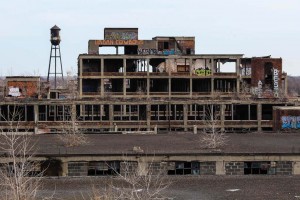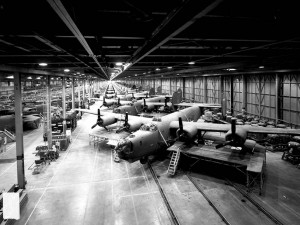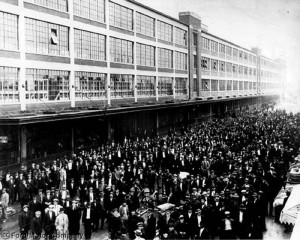During World War II they both anchored the mighty military production base that came to be known as the “Arsenal of Democracy,” but today, the old Packard and Willow Run assembly plants are symbols of the decay of the Motor City and its once-formidable manufacturing base.
But both factories could gain a new life in the near future, one as a reminder of the region’s history, the other returning to its original purpose, albeit producing modular homes rather than automobiles. Meanwhile, a third plant that saw the birth of the moving assembly line in the years leading up to the first World War may also be salvaged.
At their peak, factories in Detroit and its suburbs produced millions of cars annually. That manufacturing prowess was central to the U.S. military effort during both World Wars and during the 1940s earned the Motor City the alternate nickname as America’s Arsenal of Democracy. Many of the factories that rolled out bombers, tanks and other war machinery are already long gone and of the few that remain, most are in fading condition.
Nowhere is that more obvious than on Detroit’s crumbling east side, once the heart of its manufacturing base. The old Packard facility served as both an assembly line, corporate headquarters and even had a test track on its vast roof. Today, parts of the facility have already caved in – partly due to the effects of time, but also due to vandals, fire and the city’s own on-and-off efforts to scrap the Packard plant.
So, when an auction was held for the remains this month it was anything but certain an acceptable bid would come along. But authorities received an unexpected offer of $6,038,000 – and from a particularly surprising source: a Texas family doctor who reportedly will team up with “partners and investors from Detroit, Wall Street and international firms,” said a spokesperson, to turn the decrepit hulk into an “economic engine” that could become part of what many hope is the nascent revival of the City of Detroit.
(Group aims to save Highland Park Assembly Plant, birthplace of the moving assembly line. Click Here for the story.)
While the investors are expected to get an extension after missing a Monday afternoon deadline to come up with cash, officials for the city and surrounding Wayne County seem comfortable the offer is real.
According to Dave Marshall, the spokesperson for the investment group, the goal is to produce modular homes at the old Packard factory, “(which) will be constructed on the site and shipped all over the world.” Marshall’s statement promised that, “Building supplies will also be made here.”
The sprawling, 35-acre complex consists of 40 individual buildings, most in serious need of repair. Simply cleaning up the site will be costly, observers caution. That has led to repeated failure as one rescue plan after another has collapsed, including a proposal to turn the facility into a modern mixed-use complex of shops, restaurants and other venues.
Not a single bidder came through with the opening $1 million bid during a first auction in September and bidding this time began at just $21,000. But authorities received a shock not only when Dr. Jill Van Horn, of Ennis, Texas, made her bid but when a second offer of $6,030,000 also came in. The lower bidder could nab the deal if the doctor’s investment group can’t deliver the required cash.
Even as the city waits to see if the old Packard plant will find a new life, organizers continue struggling to save part of the old Willow Run bomber plant just a half-hour’s drive west of Detroit.
(Old B-24 plant anchored the “Arsenal of Democracy” but may soon vanish. Click Herefor the story.)
Even those who aren’t familiar with the factory itself will remember the legendary “Rosie the Riveter,” the iconic representation of women who “manned” assembly lines across the country during World War II. The image was inspired by one of the workers at Willow Run which produced a steady stream of B-24 bombers, more than 8,000 in all by the time the fighting ended.
Built and operated by Ford during the war, the factory was later transferred to General Motors which built transmissions there for the next half century. It was closed in 2010 as the automaker emerged from Chapter 11. The trust that was set up to dispose of properties that the “old” GM abandoned in bankruptcy wants to tear the old hulk down and turn most of the 332 acres into a research and development center.
But the Yankee Air Museum, a non-profit group based at the Willow Run Airport adjacent to the old factory, wants to acquire at least part of the facility and use it to store some of its fleet. A fundraising program missed a series of deadlines, but has received another reprieve after raising more than $6 million towards an ultimate target of $8 million.
Yet another once-fabled factory Detroit factory may also be salvaged. Based in the struggling enclave of Highland Park, once one of the country’s most affluent manufacturing communities, the old Ford Model T plant was the site where the world’s first moving assembly line went into operation 100 years ago this month.
(Click Here for more on the assembly line’s centennial.)
The Woodward Avenue Action Association launched a crowdsourcing campaign in August – asking for $5 donations meant to honor the $5-a-day wages Henry Ford offered workers at the plant. As with the Willow Run facility, organizers hope to salvage just a small portion of the original Ford factory which would be turned into a heritage center as part of a long-overdue effort by the Motor City to celebrate its manufacturing heritage.



